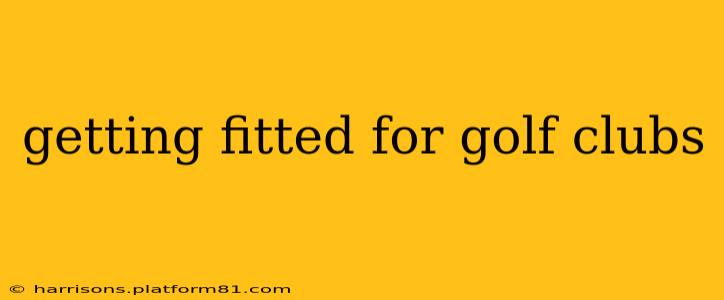Getting fitted for golf clubs is one of the best investments you can make to improve your game. A proper fitting ensures your clubs are matched to your swing, physique, and playing style, leading to increased accuracy, distance, and overall enjoyment on the course. This comprehensive guide will walk you through the entire process, answering common questions and helping you understand what to expect.
Why Should I Get Fitted for Golf Clubs?
Many golfers assume their off-the-rack clubs are sufficient, but a custom fitting reveals significant discrepancies that can severely hinder performance. A professional fitting considers various factors, including your swing speed, swing path, launch angle, spin rate, and personal preferences. This data-driven approach ensures your clubs are optimized for your game, not a generic average. The result? Straighter shots, increased distance, improved consistency, and a more enjoyable golfing experience.
What Happens During a Golf Club Fitting?
A typical fitting session involves several key steps:
-
Swing Analysis: Using sophisticated technology like TrackMan or Foresight Sports launch monitors, a club fitter analyzes your swing, measuring key parameters like swing speed, club head speed, attack angle, and more. This data provides a crucial foundation for selecting the right equipment.
-
Club Recommendation: Based on the swing analysis, the fitter will recommend specific clubs, shafts, and grips tailored to your individual needs. This includes considering your skill level, playing style, and even your physical characteristics.
-
Testing and Adjustment: You'll have the opportunity to test various club combinations to find the optimal setup. The fitter will make adjustments to shaft flex, loft, lie angle, and other parameters until they find the perfect match for your swing.
-
Final Selection and Ordering: Once you've found the best combination, the fitter will finalize your order. This usually involves specifying the club type, shaft specifications, grip size, and any other customizations.
What Type of Golf Club Fitting Should I Choose?
There are several different types of fittings available:
-
Static Fitting: A more basic fitting that focuses on measurements and calculations based on your physical characteristics and playing style. It is often less expensive than a dynamic fitting.
-
Dynamic Fitting: This is the most comprehensive type of fitting, using technology to analyze your swing in real-time and provide detailed feedback. This allows for a more precise and customized club selection.
-
On-Course Fitting: Some professional fitters offer on-course fittings, where you test clubs in a real-world playing environment. This can provide valuable insights into how the clubs perform under actual playing conditions.
What Should I Bring to My Golf Club Fitting?
To ensure a smooth and effective fitting, remember to bring:
-
Your current clubs: This allows the fitter to compare your existing clubs to the new ones.
-
Comfortable golf attire: Wear clothes that allow for a full range of motion during your swing.
-
Golf shoes: You'll be swinging the clubs, so appropriate footwear is essential.
-
An open mind: Be willing to try different clubs and listen to the fitter's recommendations.
How Much Does a Golf Club Fitting Cost?
The cost of a golf club fitting varies depending on the type of fitting, the technology used, and the fitter's experience. Generally, expect to pay anywhere from $100 to $500 or more. While it may seem like a significant upfront investment, the long-term benefits in terms of improved performance and enjoyment often outweigh the cost.
How Often Should I Get Fitted for Golf Clubs?
The frequency of fittings depends on several factors, including your skill level, how often you play, and whether you experience significant changes in your swing. For most golfers, a fitting every few years is sufficient. However, if you notice significant changes in your swing or experience consistent struggles with your game, a fitting might be sooner.
What Are the Benefits of a Golf Club Fitting?
The benefits of a professional golf club fitting are numerous:
-
Increased Distance: Optimized clubs will generally result in longer drives and overall distance.
-
Improved Accuracy: Clubs tailored to your swing will lead to more consistent shot accuracy.
-
Greater Consistency: This leads to a more enjoyable and less frustrating golf experience.
-
Enhanced Confidence: Knowing you have the right clubs boosts your confidence on the course.
-
Reduced Injuries: Correctly fitted clubs reduce stress on your body, mitigating the risk of injury.
By understanding the fitting process and its benefits, you can make an informed decision and take a significant step towards improving your game. Remember to research reputable fitters in your area and choose a professional who can provide personalized guidance and expertise. Investing in a proper golf club fitting is an investment in your enjoyment and success on the course.
